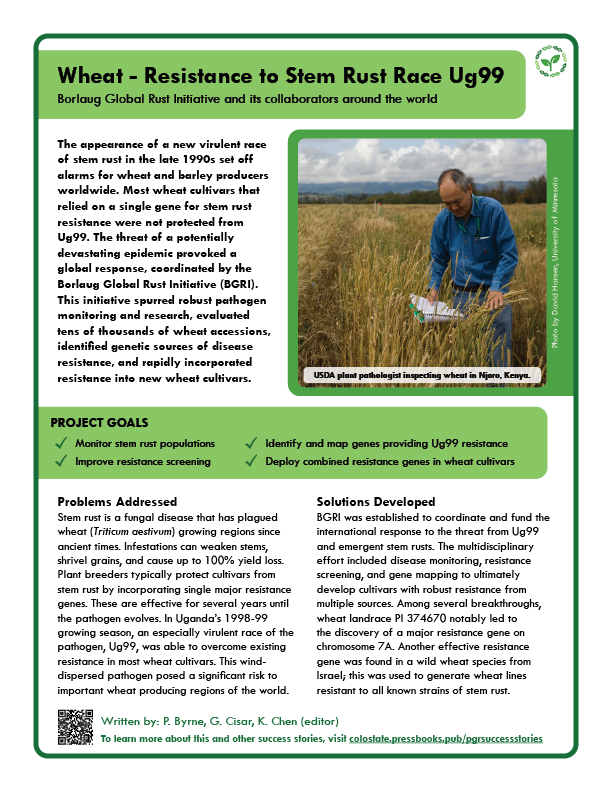Cereal Crops
Wheat – Resistance to Stem Rust Race Ug99
THE GLOBAL EFFORT TO IDENTIFY RESISTANCE TO STEM RUST RACE GROUP UG99 (TTKSK) IN WHEAT AND BARLEY
Patrick F. Byrne and Gordon Cisar
Department of Soil and Crop Sciences, Colorado State University, 307 University Ave, Fort Collins, Colorado 80523.
Borlaug Global Rust Initiative (retired), Cornell University, B75 Mann Library, Ithaca, New York 14853.
Corresponding author: patrick.byrne@colostate.edu
OUTLINE
1. SUMMARY
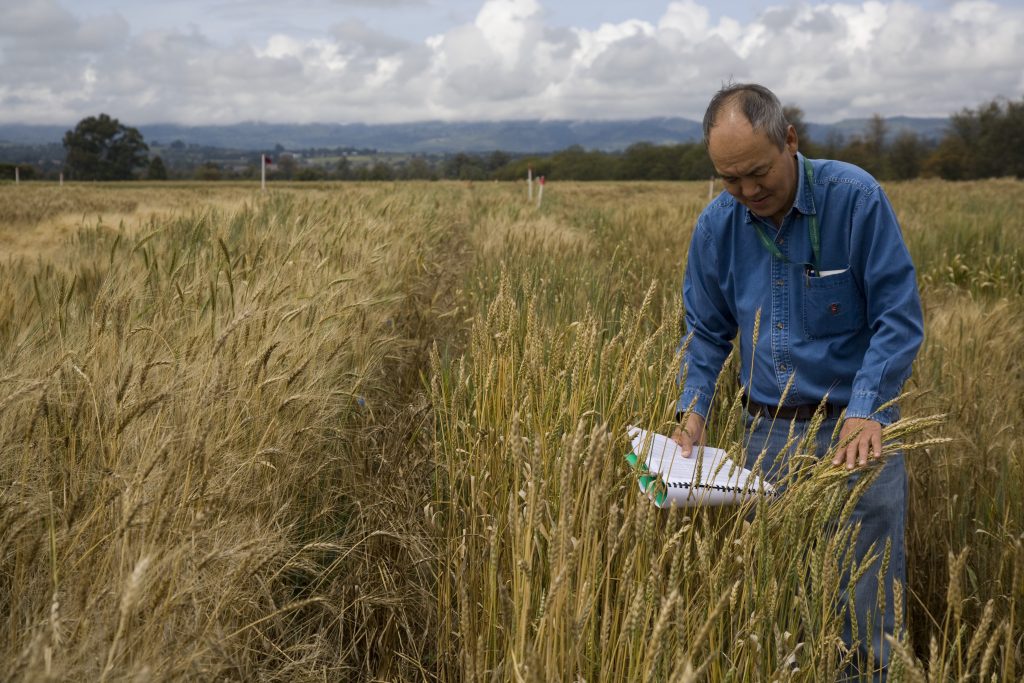
The appearance of a new virulent race of stem rust of wheat in Uganda in the 1998–1999 growing season set off alarms for this threat to wheat production worldwide. The stem rust resistance gene Sr31 from rye germplasm had been deployed in numerous cultivars around the world due to perceived stable, durable resistance. Wheat cultivars were not protected from the Ug99 race by this single gene, thus placing global wheat production at risk under a potentially devastating epidemic. The global response, coordinated by the Borlaug Global Rust Initiative, has improved monitoring of the pathogen’s spread and evolution, evaluated many tens of thousands of wheat germplasm lines, identified new sources of resistance and the causative genes, and rapidly incorporated resistance into new cultivars.
The goals were to:
- Monitor global population dynamics of the stem rust pathogen
- Improve phenotyping capability for response to stem rust infection in east Africa
- Identify novel sources of resistance to race group Ug99 in germplasm of wheat and its wild relatives
- Map the responsible resistance genes
- Deploy resistance in durable combinations in improved cultivars
Download a printable fact sheet by clicking the image below.
2. PROBLEMS ADDRESSED
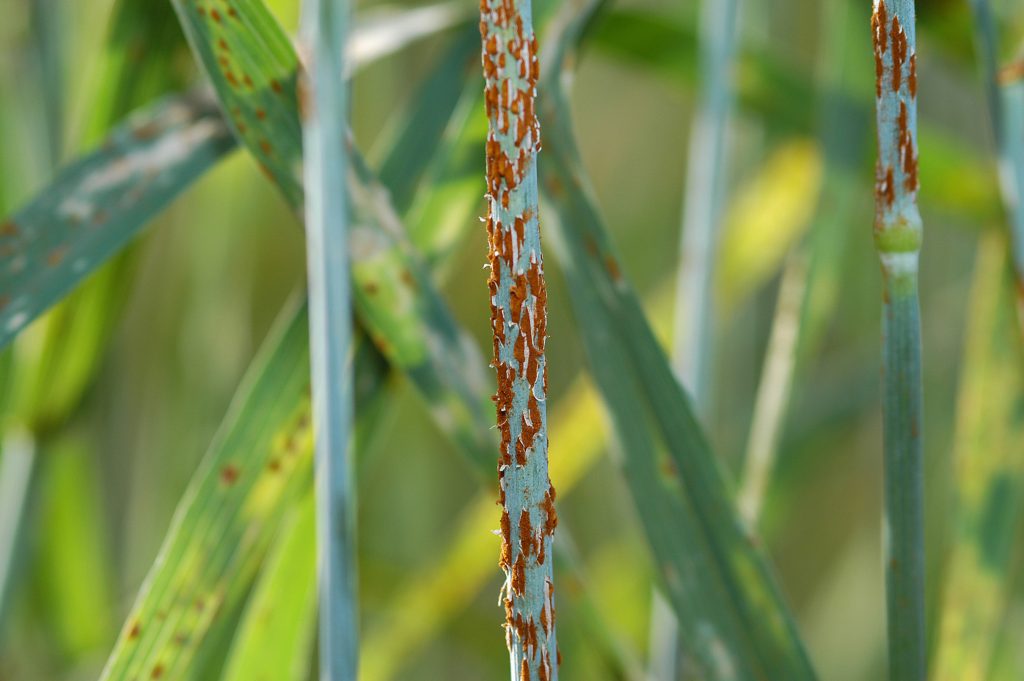
Stem rust caused by the fungus Puccinia graminis f. sp. tritici (Pgt) is a destructive disease that has plagued wheat (Triticum aestivum) growing regions since ancient times. Severe infestations impede the flow of nutrients to developing seeds, thus causing reduced grain fill and shriveled grains (Bhavani et al., 2019). In addition, weakened stems are more susceptible to lodging. Yield losses up to 100% in susceptible cultivars may occur (Olivera et al., 2015). Stem rust epidemics occurred on various continents throughout the 20th century (Bhavani et al., 2019). A diagram of the complex life cycle of Pgt is provided in Fig. 2 of Fetch et al. (2021).
Since the early 20th century, plant breeders have incorporated stem rust resistance into wheat cultivars. Typically, the resistance has been provided by single major resistance genes (R genes), which tend to be race-specific and are identified at the seedling stage. Often, they have been effective for several years before being overcome by evolution of the pathogen (Bhavani et al., 2019; Fetch et al., 2021; McIntosh et al., 1995). The preferred, more durable form of resistance is controlled by multiple, minor-effect genes, known as adult plant resistance (APR) or all-stage resistance genes, which are generally race non-specific (Bhavani et al., 2019).
The appearance of an especially virulent race of the pathogen in Uganda in the 1998–99 growing season (dubbed Ug99 or more technically the TTKSK race) galvanized global efforts to combat the disease (CIMMYT, 2005). Ug99 was able to overcome the resistance provided by the gene Sr31 from rye germplasm, which had been deployed in numerous wheat cultivars and had provided durable resistance for many years. Of particular concern was the fear that Ug99 and related races of this wind-dispersed pathogen might spread to important wheat producing regions of the Middle East and Asia. In fact, Ug99 and its relatives did spread across Eastern and Southern Africa and to Yemen and Iran (Bhavani et al. 2019). Early in 2024 a variant of Ug99 was detected in Nepal, the first occurrence in South Asia (CIMMYT, 2024). The Global Rust Initiative, later renamed the Borlaug Global Rust Initiative (BGRI), was established to coordinate and fund the international response to the threat posed by Ug99 and other emergent races.
3. SOLUTIONS DEVELOPED
The BGRI multidisciplinary and multinational response sought to: 1) increase surveillance and monitoring of wheat rust populations; 2) establish phenotyping capability to screen wheat and barley germplasm for stem rust resistance in Kenya and Ethiopia; and 3) identify new sources of resistance and characterize their resistance genes (Fetch et al., 2021; Bhavani et al., 2019).
Two examples of efforts to identify and characterize genes for stem rust resistance are described below. One features wheat landrace germplasm maintained by the U.S. National Plant Germplasm System (NPGS) and the other features Israeli germplasm of a wild relative of wheat.
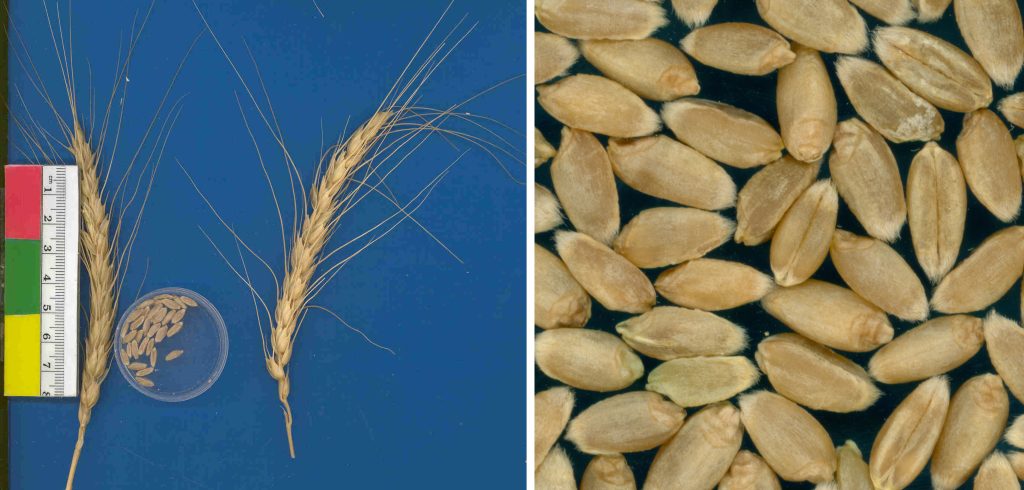
PI 374670, a landrace wheat germplasm accession in the NPGS National Small Grains Collection (NSGC) at Aberdeen, Idaho, was resistant to the Ug99 race group in field trials of 2,500 NSGC accessions in Kenya (Newcomb et al., 2016). It was crossed to the susceptible line LMPG-6 to develop three types of gene mapping populations for which analysis of screenhouse and field data revealed a major resistance gene on the long arm of chromosome 7A (Babiker et al., 2015). The authors concluded that the detected gene was a novel source of resistance, either closely linked or allelic to Sr15.

In addition to extensive evaluation of wheat collections, many studies have been conducted to locate sources of genetic resistance in germplasm of wild species (Fetch et al., 2021). Aegilops sharonensis, a wild diploid relative of wheat, is the source of another highly effective stem rust resistance gene, Sr62. The gene was identified and cloned following genome sequencing of a line derived from Ae. sharonensis accession AEG-1644 (Yu et al., 2017; 2022). The gene was inserted through genetic engineering into the susceptible wheat cultivar ‘Fielder,’ generating lines that are resistant to all known strains of the pathogen, including the Ug99 race group. Recognizing the risks of deploying single resistance genes, the authors proposed that this gene be used in ‘stacks’ that combine several resistance genes in the same cultivar.
Innumerable individuals have contributed to research, deployment, and communication concerning race group Ug99. Deserving of special mention is Dr. Norman Borlaug, whose work on Green Revolution wheat included selecting for stem rust resistance, and who helped raise international awareness about Ug99 (CIMMYT, 2005).
Among the many organizations that have played major roles are BGRI, the Rockefeller Foundation, the Ethiopian Agricultural Research Organization, the Kenya Agricultural and Livestock Research Organization, CIMMYT, ICARDA, Cornell University, the USDA-ARS Cereal Disease Laboratory, the USDA-ARS Small Grains and Potato Germplasm Research Unit, Agriculture and Agri-Food Canada, the Bill and Melinda Gates Foundation, the United Kingdom Department for International Development, the Plant Breeding Institute, Sydney, Australia, and the University of the Free State, Bloemfontein, South Africa.
4. IMPACT
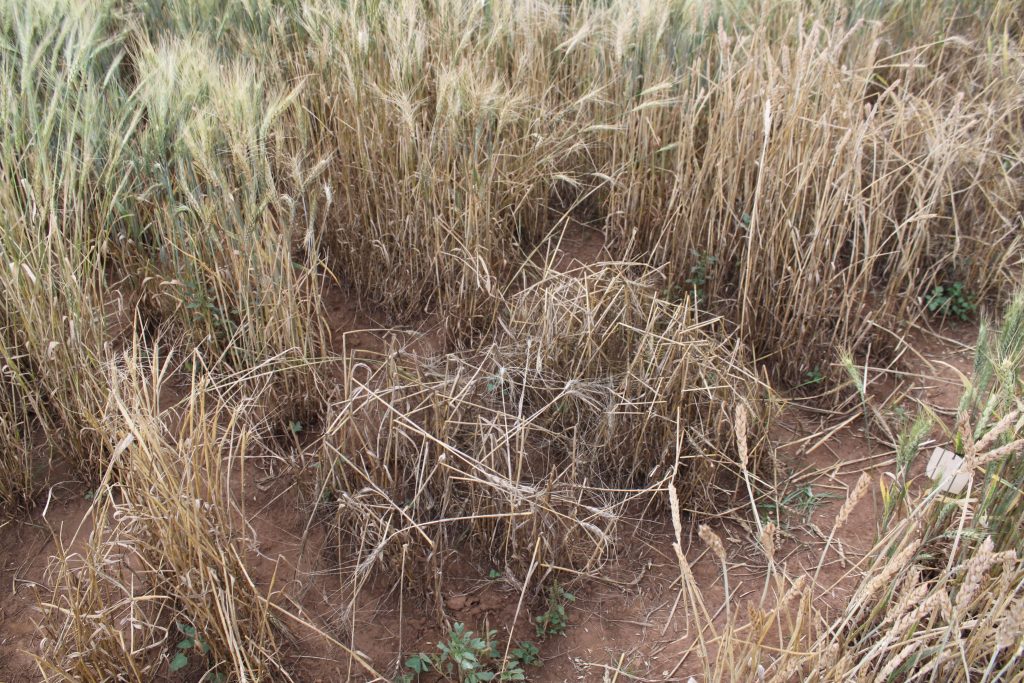
Improved surveillance and monitoring of stem rust races provide the agricultural community with advance warning of when and where epidemics might occur. Enhanced phenotyping capability in Kenya and Ethiopia have been critical to ensuring accurate evaluation and selection of resistant lines. According to Bhavani et al. (2019), over 100 stem rust resistant or moderately resistant cultivars have been released, based partly on their evaluation at Njoro, Kenya. Mapping of new resistance genes effective against the evolving pathogen population and identifying linked molecular markers enable rapid development of cultivars with combinations of resistance genes, the best strategy for durable stem rust resistance.
5. GERMPLASM
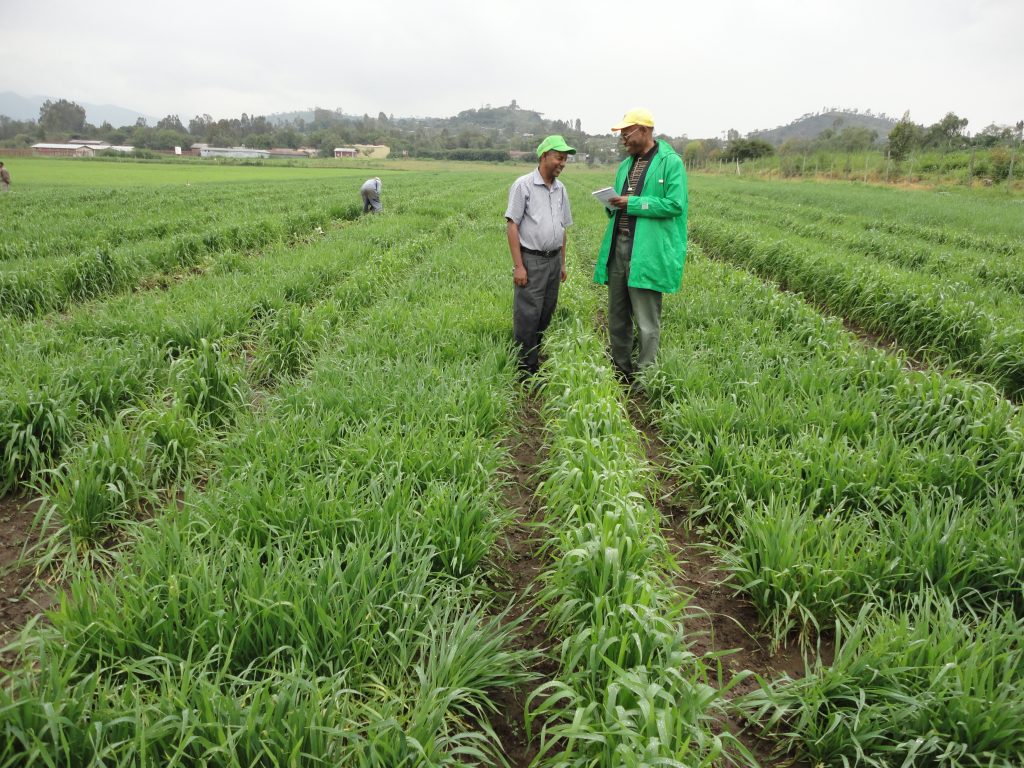
Many thousands of genebank accessions, breeding lines, and released cultivars have been evaluated for stem rust response in Njoro, Kenya—a stem rust hotspot. Bhavani et al. (2019) stated that nearly 600,000 wheat accessions from dozens of countries were evaluated at Njoro from 2005 to 2018. Accession PI 374670 is a common wheat landrace accession from the NSGC that was collected in 1971 in Bosnia and Herzegovina. In evaluations over eight field seasons in Njoro, Kenya, it was rated ‘moderately resistant’ to Ug99 (Newcomb et al., 2016).
Accession AEG-1644 of Aegilops sharonensis, collected in Ashdod, Israel and conserved by Tel Aviv University, is highly resistant to Ug99 and served as a parent of a mapping population to locate the genes controlling resistance in that accession (Yu et al., 2017; 2022; Millet et al., 2017). Two such genes were found; the gene on chromosome 1S was chosen for cloning and insertion into wheat (Yu et al., 2022).
6. REFERENCES
Babiker EM, Gordon TC, Chao S, Newcomb M, Rouse MN, et al. 2015. Mapping resistance to the Ug99 race group of the stem rust pathogen in a spring wheat landrace. Theoretical and Applied Genetics 128:605-612. https://doi.org/10.1007/s00122-015-2456-6
Bhavani S, Hodson DP, Huerta-Espino J, Randhawa M, Singh RP. 2019. Progress in breeding for resistance to Ug99 and other races of the stem rust fungus in CIMMYT wheat germplasm. Frontiers of Agricultural Science and Engineering 6:210-224. https://doi.org/10.15302/J-FASE-2019268
CIMMYT. 2024. Successful surveillance results in early first detection of Ug99 in South Asia. Accessed April 8, 2024. Available from: https://www.cimmyt.org/news/successful-surveillance-results-in-early-first-detection-of-ug99-in-south-asia/
CIMMYT. 2005. Sounding the alarm on global stem rust: an assessment of race Ug99 in Kenya and Ethiopia and the potential for impact in neighboring regions and beyond. Download from: https://bgri.cornell.edu/wp-content/uploads/2020/12/SoundingAlarmGlobalRust.pdf
Fetch TG, Park RF, Pretorius ZA, Depauw RM. 2021. Stem rust: its history in Kenya and research to combat a global wheat threat. Canadian Journal of Plant Pathology 43:S275-S297. https://doi.org/10.1080/07060661.2021.1902860
McIntosh, RA, Welling, CR, Park, RF. 1995. Wheat rusts: An atlas of resistance genes. CSIRO Australia, 1995. ISBN 0 642 05428 6
Millet E, Steffenson BJ, Prins R, Sela H, Przewieslik-Allen AM, et al. 2017. Genome targeted introgression of resistance to African stem rust from Aegilops sharonensis into bread wheat. The Plant Genome 10:plantgenome2017.07.0061. https://doi.org/10.3835/plantgenome2017.07.0061
Newcomb M, Acevedo M, Bockelman HE, Brown-Guedira G, Goates BJ, et al. 2013. Field resistance to the Ug99 race group of the stem rust pathogen in spring wheat landraces. Plant Disease 97:882-890. https://doi.org/10.1094/PDIS-02-12-0200-RE
Olivera P, Newcomb M, Szabo LJ, Rouse M, Johnson J, et al. 2015. Phenotypic and genotypic characterization of race TKTTF of Puccinia graminis f. sp. tritici that caused a wheat stem rust epidemic in southern Ethiopia in 2013–14. Phytopathology 105:917-928. https://doi.org/10.1094/PHYTO-11-14-0302-FI
Yu G, Champouret N, Steuernagel B, Olivera PD, Simmons J, et al. 2017. Discovery and characterization of two new stem rust resistance genes in Aegilops sharonensis. Theoretical and Applied Genetics 130:1207-1222. https://doi.org/10.1007/s00122-017-2882-8
Yu G, Matny O, Champouret N, Steuernagel B, Moscou MJ, et al. 2022. Aegilops sharonensis genome-assisted identification of stem rust resistance gene Sr62. Nature Communications 13:1607. https://doi.org/10.1038/s41467-022-29132-8
Yu L-X, Barbier H, Rouse MN, Singh S, Singh RP, et al. 2014. A consensus map for Ug99 stem rust resistance loci in wheat. Theoretical and Applied Genetics 127:1561-1581. https://doi.org/10.1007/s00122-014-2326-7
7. CHAPTER INFORMATION
Citation: Byrne P, Cisar G. 2024. Wheat – Resistance to Stem Rust Race Ug99. In: Volk GM, Chen K, Byrne P (Eds.) Plant Genetic Resources: Success Stories. Fort Collins, Colorado: Colorado State University. Date accessed. Available from https://colostate.pressbooks.pub/pgrsuccessstories/chapter/wheat-resistance-to-stem-rust-race-ug99/
Content originally submitted: January 22, 2024
Date of publication: April 15, 2024
USDA is an equal opportunity provider, employer, and lender. Mention of trade names or commercial products in this article is solely for the purpose of providing specific information and does not imply recommendation or endorsement by the U.S. Department of Agriculture.

